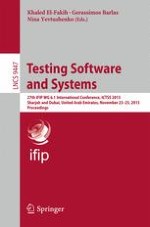2015 | Buch
Testing Software and Systems
27th IFIP WG 6.1 International Conference, ICTSS 2015, Sharjah and Dubai, United Arab Emirates, November 23-25, 2015, Proceedings
herausgegeben von: Khaled El-Fakih, Gerassimos Barlas, Nina Yevtushenko
Verlag: Springer International Publishing
Buchreihe : Lecture Notes in Computer Science
